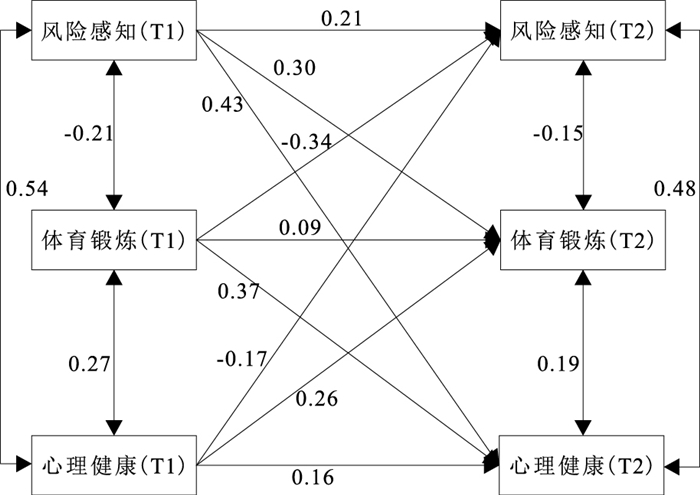Association of COVID-19 epidemic risk perception, physical exercise and mental health in college students
-
摘要:
目的 了解大学生新冠肺炎疫情风险感知、体育锻炼与心理健康的内在机制,为有效缓解常态化疫情防控背景下大学生心理健康问题提供理论依据。 方法 采用纵向设计,使用心理症状自评量表(SCL-90)、体育锻炼等级量表(PARS-3)、新冠肺炎疫情风险感知量表分别于2021年12月(T1)和2022年3月(T2)方便抽取郑州、北京、沈阳、天津4个地区16所高校的973名大学生进行2次追踪调查。 结果 2次调查,男、女生在新冠肺炎疫情风险感知变量上差异无统计学意义(Z值分别为-1.81,-1.82,P值均>0.05),在体育锻炼和心理健康2个变量上存在跨群组的性别差异(T1:Z值分别为-0.98,-4.84;T2:Z值分别为-0.86,-4.64,P值均<0.01),男生的体育锻炼和心理健康状况优于女生;大学生在新冠肺炎疫情风险感知、体育锻炼与心理健康上存在稳定、同步相关性(r=-0.31~0.54,P值均<0.01);大学生新冠肺炎疫情风险感知T1能够预测体育锻炼和心理健康T2(β值分别为0.30,0.43,P值均<0.01),体育锻炼T1能够预测心理健康T2(β=0.37,P<0.01),且在新冠肺炎疫情风险感知与心理健康的影响路径上,体育锻炼具备中介作用。 结论 新冠肺炎疫情风险感知、体育锻炼与心理健康存在纵向因果关系,依据性别提高大学体育锻炼意识对改善心理健康具有现实意义。 Abstract:Objective To understand the inter-relationships among COVID-19 risk perception, physical exercise and mental health among college students, and to provide basis for effective mental health promotion of college students under the context of normal epidemic prevention and control. Methods By using a longitudinal design, in December 2021 (T1) and March 2022 (T2), 2 follow-up surveys were conducted among 973 college students from 16 colleges and universities in Zhengzhou, Beijing, Shenyang and Tianjin, by using the Symptom Check List-90(SCL-90), Physical Exercise Rating Scale (PARS-3) and COVID-19 Epidemic Risk Perception Scale. Results There was no significant difference in risk perception of COVID-19 between boys and girls(Z=-1.81, -1.82, P>0.05), while there were cross-group gender differences in physical exercise and mental health variables(T1:Z=-0.98, -4.84; T2:Z=-0.86, -4.64, P < 0.01), with boys were better than girls in physical exercise and mental health; There was a stable and synchronous correlation between the risk perception of COVID-19 epidemic, physical exercise and mental health of college students(r=-0.31-0.54, P < 0.01); Early risk perception of COVID-19 (T1) could predict later physical exercise and mental health (T2) of college students(β=0.30, 0.43, P < 0.01), early physical exercise (T1) could predict later mental health(T2)(β=0.37, P < 0.01), and physical exercise had a mediating effect on the association between COVID-19 risk perception and mental health. Conclusion There is a longitudinal causal relationship between COVID-19 risk perception, physical exercise and mental health. It is of practical significance to improve college physical exercise awareness based on gender. -
Key words:
- Coronavirus /
- Exercise movement techniques /
- Mental health /
- Students
1) 利益冲突声明 所有作者声明无利益冲突。 -
表 1 不同性别大学生新冠肺炎疫情风险感知体育锻炼及心理健康得分比较[M(P25, P75)]
Table 1. Comparison of risk perception, physical exercise and mental health of college students of different genders[M(P25, P75)]
性别 人数 风险感知T1 体育锻炼T1 心理健康T1 风险感知T2 体育锻炼T2 心理健康T2 男 504 3.57(2.13,4.52) 4.06(2.46,4.43) 3.93(2.61,4.39) 3.68(2.26,4.61) 4.11(2.51,4.67) 4.12(2.21,4.34) 女 469 3.49(2.24,4.61) 3.56(2.39,4.06) 3.81(2.46,4.33) 3.36(2.27,4.66) 3.62(2.46,4.14) 3.97(2.51,4.38) Z值 -1.81 -0.98 -4.84 -1.82 -0.86 -4.64 P值 0.37 <0.01 <0.01 0.26 <0.01 <0.01 表 2 大学生新冠肺炎疫情风险感知与体育锻炼及心理健康的相关系数(r值,n=973)
Table 2. Correlation coefficient between COVID-19 risk perception of pidemic situation and physical exercise and Mental Health scores of college students(r, n=973)
变量 风险感知T1 体育锻炼T1 心理健康T1 风险感知T2 体育锻炼T2 体育锻炼T1 -0.21 心理健康T1 0.54 0.27 风险感知T2 0.11 -0.31 0.31 体育锻炼T2 -0.24 0.10 0.31 -0.12 心理健康T2 -0.17 0.26 -0.30 0.47 0.14 注: P值均<0.01。 -
[1] 国务院应对新型冠状病毒感染肺炎疫情联防联控机制. 国务院应对新型冠状病毒感染肺炎疫情联防联控机制关于做好新冠肺炎疫情常态化防控工作的指导意见[EB/OL]. (2020-05-08)[2022-07-17]. http://www.gov.cn/zhengce/content/2020-05/08/content_5509896.htm.State Council's Joint Prevention and Control Mechanism for Novel Coronavirus Infection of the PRC. Guidelines of the Joint Prevention and Control Mechanism of the State Council on the prevention and control of COVID-19 ona regular basis[EB/OL]. (2020-05-08)[2022-07-17]. http://www.gov.cn/zhengce/content/2020-05/08/content_5509896.htm. (in Chinese) [2] MODESTO L R N, HIURE G A, JOANA D E, et al. When health professionals look death in the eye: the mental health of professionals who deal daily with the 2019 coronavirus outbreak[J]. Psychiatry Res, 2020, 288(6): 112972. [3] FISCHHOFF B. Risk perception and communication unplugged: twenty years of process[J]. Risk Analy, 2010, 15(2): 137-145. [4] HAN Q, ZHENG B, AGOSTINI M, et al. Associations of risk perception of COVID-19 with emotion and mental health during the pandemic[J]. J Affec Disord, 2021, 284(7): 247-255. [5] 谢戴西, 王晓东. 风险感知对大学生新冠预防行为及锻炼行为坚持性的影响[J]. 体育学刊, 2021, 28(5): 100-107. https://www.cnki.com.cn/Article/CJFDTOTAL-TYXK202105016.htmXIE D X, WANG X D. The influence of risk perception on university student's persistence in preventive behavior for COVID-19 and exercise behavior[J]. J Phys Educ, 2021, 28(5): 100-107. (in Chinese) https://www.cnki.com.cn/Article/CJFDTOTAL-TYXK202105016.htm [6] 林晓桂, 徐建清. 新型冠状病毒肺炎疫情下体育锻炼对大学生心理健康的影响[J]. 中国学校卫生, 2020, 41(11): 1682-1687. doi: 10.16835/j.cnki.1000-9817.2020.11.023LIN X G, XU J Q. Influence of physical exercise on mental health of college students during the epidemic of COVID-19[J]. Chin J Sch Health, 2020, 41(11): 1682-1687. (in Chinese) doi: 10.16835/j.cnki.1000-9817.2020.11.023 [7] 王征宇. 症状自评量表(SCL-90)[J]. 上海精神医学, 1984(2): 68-70. https://www.cnki.com.cn/Article/CJFDTOTAL-JSYI198402006.htmWANG Z Y. Symptom Self-rating Scale(SCL-90)[J]. Shanghai Arch Psychiatry, 1984(2): 68-70. (in Chinese) https://www.cnki.com.cn/Article/CJFDTOTAL-JSYI198402006.htm [8] 梁德清. 高校学生应激水平及其与体育锻炼的关系[J]. 中国心理卫生杂志, 1994, 8(1): 5-6. https://www.cnki.com.cn/Article/CJFDTOTAL-ZXWS401.001.htmLIANG D Q. The stress level of college students and its relationship with physical exercise[J]. Chin Ment Health J, 1994, 8(1): 5-6. (in Chinese) https://www.cnki.com.cn/Article/CJFDTOTAL-ZXWS401.001.htm [9] 崔小倩, 郝艳华, 唐思雨, 等. 新冠肺炎疫情风险感知量表信效度检验及应用: 基于大数据样本的实证研究[J]. 中国公共卫生, 2021, 37(7): 1086-1089. https://www.cnki.com.cn/Article/CJFDTOTAL-ZGGW202107010.htmCUI X Q, HAO Y H, TANG S Y, et al. Reliability and validity of a self-designed COVID-19 risk perception scale: a large online empirical study[J]. Chin Public Health, 2021, 37(7): 1086-1089. (in Chinese) https://www.cnki.com.cn/Article/CJFDTOTAL-ZGGW202107010.htm [10] 周浩, 龙立荣. 共同方法偏差的统计检验与控制方法[J]. 心理科学进展, 2004, 12(6): 942-950. https://www.cnki.com.cn/Article/CJFDTOTAL-XLXD200406017.htmZHOU H, LONG L R. Statistical remedies for common method biases[J]. Psychol Sci Adv, 2004, 12(6): 942-950. (in Chinese) https://www.cnki.com.cn/Article/CJFDTOTAL-XLXD200406017.htm [11] 吴静涛, 赵新娟, 赵文楠, 等. 体育锻炼对大学生负性情绪的影响: 自我效能感的中介作用[J]. 中国健康心理学杂志, 2022, 30(6): 930-934. https://www.cnki.com.cn/Article/CJFDTOTAL-JKXL202206027.htmWU J T, ZHAO X J, ZHAO W N, et al. Effect of physical exercise on negative emotions of college students: the mediating role of self-efficacy[J]. Chin J Health Psychol, 2022, 30(6): 930-934. (in Chinese) https://www.cnki.com.cn/Article/CJFDTOTAL-JKXL202206027.htm [12] 时容华. 社会心理学[M]. 上海: 上海人民出版社, 1986: 139.SHI R H. Social psychology[M]. Shanghai: Shanghai Renmin Chubanshe, 1986: 139. (in Chinese) [13] 库卡特·考夫卡. 格式塔心理学原理[M]. 李维, 译. 北京: 北京大学出版社, 2010: 34-37.KURT K. Principle of gestalt psychology[M]. LI W, translate. Beijing: Peking University Press, 2010: 34-37. (in Chinese) [14] 翟文海, 张琼, 胡卫, 等. 新冠肺炎疫情发生前后中国大学生焦虑症状及相关因素的Meta分析[J]. 中国心理卫生杂志, 2022, 36(7): 626-632. https://www.cnki.com.cn/Article/CJFDTOTAL-ZXWS202207014.htmZHAI W H, ZHANG Q, HU W, et al. A Meta-analysis of anxiety symptoms and related factors in Chinese college students before and after the COVID-19 epidemic[J]. Chin Ment Health J, 2022, 36(7): 626-632. (in Chinese) https://www.cnki.com.cn/Article/CJFDTOTAL-ZXWS202207014.htm [15] 韩娜娜, 王爱文, 余蕾, 等. COVID-19流行期间体力活动助力疫情防控的潜在生物学机制[J]. 首都体育学院学报, 2021, 33(4): 384-395. https://www.cnki.com.cn/Article/CJFDTOTAL-BTSF202104006.htmHAN N N, WANG A W, YU L, et al. Potential biological mechanism of physical activity to help epidemic prevention and control during the COVID-19 pandemic[J]. J Capital Univ Phys Educ Sports, 2021, 33(4): 384-395. (in Chinese) https://www.cnki.com.cn/Article/CJFDTOTAL-BTSF202104006.htm [16] KIECOLTGLASER J K, MCGUIRE L, ROBLES T F, et al. Emotions, morbidity, and mortality: new perspectives from psychoneuroimmunology[J]. Ann Rev Psychol, 2002, 53(1): 83. [17] REBAR A L, STANTON R, GEARD D, et al. A meta-meta-analysis of the effect of physical activity on depression and anxiety in non-clinical adult populations[J]. Health Psychol Rev, 2015, 9(3): 366. [18] NIELSEN H G, LYBERG T. Long-distance running modulates the expression of leucocyte and endothelial adhesion molecules[J]. Scand J Immunol, 2004, 60(4): 356. [19] BIDDLE S, ASARE M. Physical activity and mental health in children and adolescents: a review of reviews[J]. Br J Sports Med, 2011, 45(11): 886-895. -







 下载:
下载:

